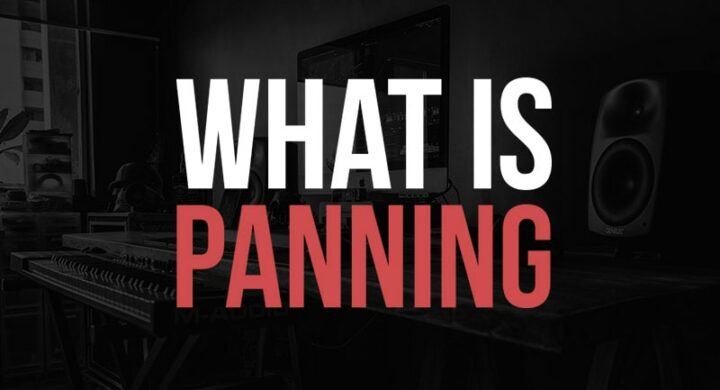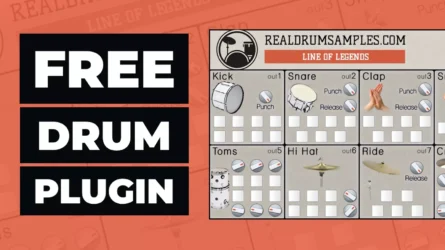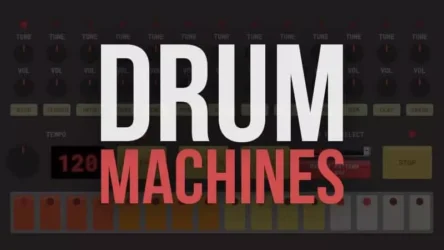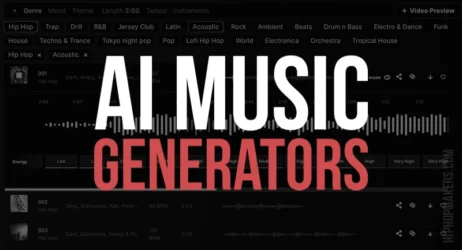In this guide we will answer what is panning in music, how it works, provide examples, and include tutorials on how to use panning in music.
- What Is Audio Panning
- How Does Panning Work
- What Does Panning Sound Like
- How Do You Use Panning In Music
- What Are Examples Of Panning
- Why Use Audio Panning
- Stereo vs. Panning
- Who Invented Panning In Music
What Is Audio Panning?
Panning is the process of adjusting the position of a sound in a stereo or multi-track recording. It can be used to place a particular instrument or voice in a specific location in the mix or to create the illusion of movement across the stereo field.
Panning is done by manipulating the volume of a sound at different points in time, which creates the illusion that the sound is moving from side to side.
The pan knob on your audio interface allows you to do this in real time while you’re playing or recording.
By turning it to the left, you’ll reduce the sound volume coming out of the right speaker and vice versa. This will create an image of the sound moving from left to right across your stereo field.

Let’s say you’re recording a guitar solo. If you pan the sound to the left, it will only come out of the left speaker. If you pan it to the right, it will only come out of the right speaker. But if you pan it to the center, both speakers will play the same volume of sound at the same time.
Panning is usually used on guitars, pianos, strings, or pads. It can also be applied to lead vocals or solos. You’d typically leave your drums panned to the center so they’re spread evenly across your speakers/monitors. A lot of modern recordings are done with everything panned to the middle for this very reason.
Some people like to create a natural surround sound feeling, while others like to make an artificial stereo imaging effect. It depends on the context of the track and your personal preferences as a producer.
The technique is somewhat subjective and can be used for different purposes depending on how you use it. For example, some engineers like to make images wider with heavy panning (left/right), which will give more width to an otherwise mono-sounding mix. Others do the opposite and pan everything all the way to one side; this creates dramatic effects where sounds appear either in front or behind the listener.
How Does Panning Work?
When you pan an audio source, you are essentially telling the listener’s brain which ear should be focused on that sound. By moving a sound from one side of the stereo field to the other, you create the illusion of hearing that sound coming from different locations in space.
Panning can be used for many purposes, such as creating a sense of depth, directing the listener’s attention, or adding excitement to a mix. It can also be used to make mono tracks sound more stereo.
There are many different ways to pan the audio, and the technique you use will depend on the song and the effect you’re trying to achieve.
What Does Panning Sound Like?
Panning can make a track sound more spacious and three-dimensional when done correctly. It can also help create a sense of depth and separation between different instruments.
Some people find panning to be distracting, primarily when used excessively. However, it can be an effective tool for enhancing your mixes when used in moderation.
So, what does panning sound like? It depends on how you use it. But, generally speaking, it can add a lot of depth and realism to your music.
How Do You Use Panning In Music?
In music, panning is the technique of positioning a sound in a stereo field. This can be done by adjusting the volume of each track to create a sense of space, or it can be done by using special effects to create the illusion of movement.
There are two main ways to use panning in music: as a creative tool and create a sense of space.
Creatively, panning can be used to create the illusion of movement. For example, you can pan a sound from left to right to make it sound like it’s moving across the stereo field. Or, you can pan a sound up and down to make it sound like it’s moving up and down. This is sometimes called “slip-panning.”
You can also use panning to create movement without moving the sound across the stereo field. This can be done by making a sound pan left and right, and then using an effect that makes it gradually fade in and out. This way, it sounds like the sound is moving up and down even though it’s not actually moving anywhere.
Panning can also be used to simulate space. For example, you could have a short delay set to ping-pong back and forth between two speakers, or you could do something more complex such as setting up multiple delay lines with independent filters for each delay line so that they react independently of each other. The possibilities here are endless.
What Are Examples Of Panning?
There are many examples of panning in the music industry. Below are examples of some albums that carry songs that are great examples of panning used in music. Let’s take a look at some examples of panning techniques used in music.
“Electric Ladyland” By Jimi Hendrix
Jimi Hendrix’s “Electric Ladyland” is a rock and roll album with songs that predominantly use panning in music techniques.
This means that the sound you hear coming out of your speakers will constantly change, making it feel like you’re constantly moving in headspace with the song.
For example, in the song “1983…(A Merman I Shall Turn To Be)”, you’ll hear the instruments pan left to right constantly through your speakers, making it feel as if you’re swimming along with the song.
What is most interesting about this album is how innovative Jimi Hendrix was regarding audio engineering techniques. The album was released in 1968 when panning was not as widely used as it is today.
“Tell All Your Friends” By Taking Back Sunday
Taken back Sunday’s “Tell All Your Friends” is an album that uses panning in music techniques.
For example, in the song “Cute Without The ‘E’ (Cut From The Team),” the guitars are panned to the left and right channels.
This gives the listener a feeling that they’re in the room with the band. It puts them right in the middle of the action.
Why Use Audio Panning?
Audio panning is a great tool to use when mixing audio. It allows you to move a track around the stereo field, creating interesting new effects. Also, it helps to give a track a sense of depth and distance.
Musicians use panning because it gives them control over their mixes. They can pan a sound to any part of the stereo field, including off to the sides. And they can adjust how much of the sound gets sent to each speaker. This means that they can change the volume of a particular instrument at will, regardless of where it is located in the stereo field.
What Is The Difference Between Stereo & Panning?
Stereo is a type of sound reproduction that creates the illusion of three-dimensional space. This is done by encoding two slightly different signals into two channels (left and right), which are then played back through two speakers placed apart from one another.
On the other hand, panning is a technique used in mixing to move sounds from one channel to another. This can be done to create a more immersive sonic experience or highlight certain mixed elements. It can also be used for creative effects, such as making a sound seem like it’s moving around the listener’s head.
Who Invented Panning In Music?
The origins of panning are murky, but there are several competing theories about who invented it. One theory credits audio pioneer Alan Dower Blumlein with the invention in 1931, while another claims that John Henry Faulkner came up with the idea in 1957.
However, there is evidence that earlier experiments with panning influenced both men, so it’s hard to say definitively who deserves the credit.
Recommended Tools
Here are the most popular audio mixing products on Amazon.
No products found.
Audio Panning Overview
Panning is the process of moving audio to the left or right audio channel. Panning is a technique used to liven up a song and add depth to music. It also makes it sound more dynamic. It is used in all genres of music with many different instruments and vocals.
The art of panning in music production is a fundamental concept that every music producer should master. Using analog control, like a typical physical recording console, or on-screen virtual knobs, you can manage the pan control setting, adjusting sounds between left and right buses.
This panning technique allows you to shift a stereo or mono track, creating a stereo mix with a defined space in your audience’s perception.
The pan positions for instruments can be set using simple analog pan controls, letting you guide the audio signal from the left speaker to the right or any point in-between.
Consider panning instruments and other sounds across the stereo channels to make them sound natural, occupying the same space or separate spaces in the stereo width.
The right and left sides of the mix music should each hold different elements for the best results, creating an immersive experience that can mimic moving image technology in its depth and range.
For example, lead vocals are often placed in a center pan position, with an equal volume in both left and right channels, while background vocals or other instruments may be panned to the left or right side.
Such panning examples offer listeners a full range of stereo sounds, providing an experience akin to what they would hear at a live performance.
Hard panning, placing an audio signal entirely in one speaker, is typically used to create interest or highlight certain instruments. Conversely, off-center pans are used to create a less extreme spatial effect.
Experiment with panning automation, where pan controls change during the course of a track.
For instance, an instrument may start off on the left side and gradually move to the right. Remember, mono sounds and most studio tracks can be made more interesting with different pan positions, from extreme left to center to the right.
Finally, here are some bonus tips: Keep an eye on the position indicator, and don’t forget to mix sounds using your left ear and right ear to check the balance.
And remember, some elements, like lead vocals, are usually in the center, while other instruments can be panned to the left or right for an interesting stereo track.
Don’t be afraid to experiment with panning in your music production – it’s one of the most important elements of a good mix. Listen to different styles of music to hear examples of effective panning.
So, whether you’re using a typical physical recording console with an analog control or a computer with on-screen virtual knobs, the key to effective audio panning lies in understanding and experimenting with these principles.
Through consistent practice, these techniques will enable you to produce a sound that not only feels genuine, but also distinctive and thrilling.
I hope you now have a better understanding of audio panning and how it applies to music production.




